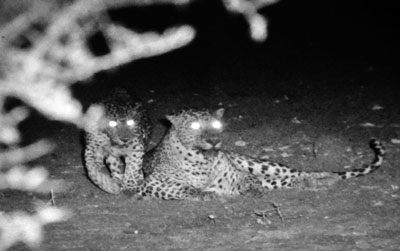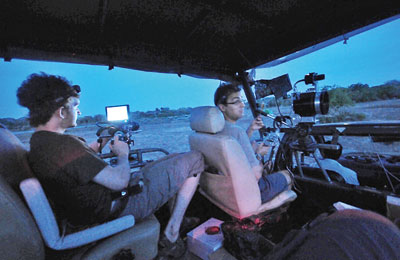They drove through Yala in the still of the night experiencing a strange silent world so different to the dusty scrub jungle by day. “47 days of filming at night brought its rewards: 106 leopard sightings in 46 nights, 11 of sloth bears, five of rusty spotted cats, 14 of cobras and seven of pythons along with countless elephants arriving to water at Gonagala and Heenwewa tanks.”The mission was a film to bring Yala’s amazing wildlife, to the spotlight. But unlike the many wildlife films done before, this one made for the National Geographic Channel, titled ‘Night Stalkers’ would focus on Yala’s top predator, the leopard and its behaviour under cover of darkness.
 |
 |
For Chitral Jayatilaka, head of Eco-tourism and Special Projects at John Keells, accustomed as he is to the wild, it was a rare privilege. Ten years ago, the BBC film ‘The Leopard Hunters’ done with the late Dr. Ravi Samarasinghe and Jehan Kumara had brought Yala’s leopards to a world audience and to help make such a film on the big cats’ behaviour at night, was for Chitral, a dream realised, another step in the larger mission to conserve this awesome wealth through knowledge and awareness.
It all began in May 2010 when Chitral was contacted by Thomas Stephens, a young producer at Ammonite, UK, about making a leopard documentary at Yala focusing on the big cat’s behaviour at night.
“I invited Tom to visit Sri Lanka in early June for a recce and drove him to Yala. Enroute, we met the Director General of the Department of Wildlife Conservation and presented our plans of filming these elusive cats at night. The three-day recce was a great success, with many leopards seen, and the experiment of staying out at the park one night after closing time with the kind assistance of the DWC worked well in spotting several large males at night. Tom was convinced that Yala was indeed the place to make his movie designed for Nat Geo Wild,” says Chitral.
Four weeks of meticulous planning followed, custom-designing filming doors fabricated in Tissa, seats removed to house two thermal cameras and modified desktop computers on board the jeeps. The Nature Trails team at Chaaya Wild awaited the arrival of the Ammonite crew led by Martin Dhorn.
“On July 7, we were all set for our first night of filming. Kalu, our faithful driver carefully selected for the filming jeep, needed reassurance in driving through night vision. I took on the wheel of the Tata myself; driving up to the main gate was easy, but negotiating the jeep through the narrow gates certainly tested my night vision driving skills,” says Chitral.
“We headed straight up towards the Yala junction when the spotter jeep picked up one of the ‘Suduwelimulla Cubs’ ahead. I gently manoeuvred the jeep into position and spotted the cub seated on the drain by the road, relaxed though watching the jeep.
“Thirty minutes later, to our total surprise, the cub stood up, stretched and began walking straight up to the filming jeep. Tom whispered to me, “Back up CJ, he’s too close…” and I did, looking through Yukon night vision goggles; another first – reversing a jeep through Infra Red vision.”
Over the weeks that followed, they had numerous sightings and were able to capture remarkable images of the big cats as they moved freely at night —a leopard family, father, mother and two cubs, leopards mating by the roadside and a young leopard’s chase for prey up a tree- unsuccessful as it turned out and much more of the interaction too between the leopards and other animals at Yala including a rare sequence of a female leopard’s battle to protect her kill from wild boar, buffalo and crocodile .
Adds Chitral, “I felt as if I sat on the top of the world when we drove into the ‘Buttuwa’ plains one September night for a final still image of the crew that completed this amazing task. A 30-second long exposure, we stood motionless until Tom said he was happy with the symbolic image that marked the completion of Night Stalkers.”
Fourteen months later, the completed documentary aired in the US and UK has had rave reviews. Yala’s leopards’ cover of darkness had been broken with the aid of state of the art technology and a team of men determined to observe, document and share the secret lives of leopards at night.
The film was shown last week to a group of conservationists and journalists and hopefully will be aired on local TV soon. |



